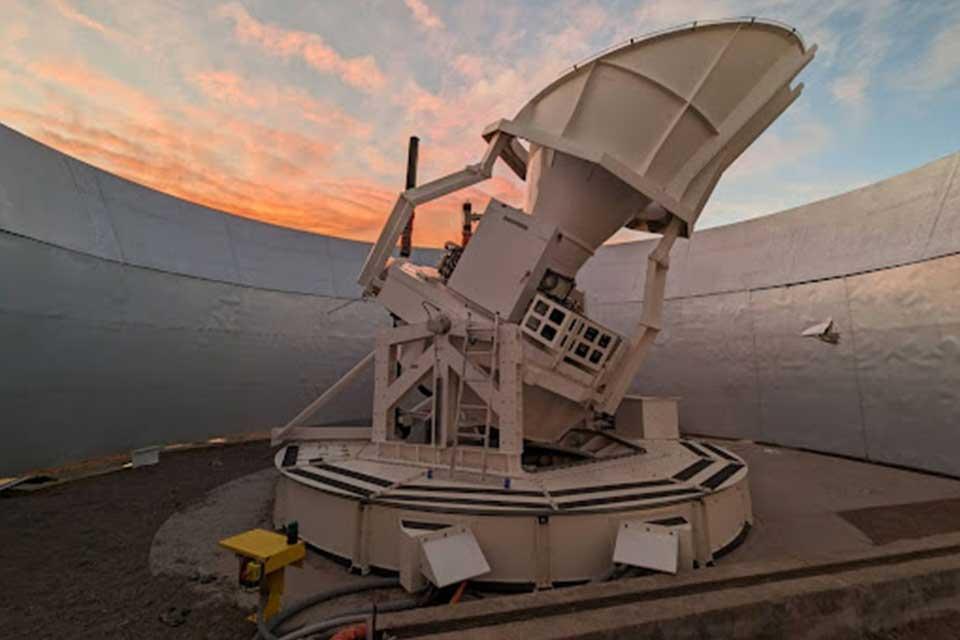A consortium of scientists across six UK universities have been awarded an STFC Astronomy Large Award to fund their work analysing data from the Simons Observatory. The Simons Observatory – a collection of ground-based telescopes in Chile’s Atacama Desert – is an ambitious experiment to study the Cosmic Microwave Background (CMB), the first light emitted after the Big Bang. The project is led by Professor David Alonso from the Beecroft Institute for Particle Astrophysics and Cosmology at the Department of Physics. Here he talks about what the funding means and how it might shed light on dark matter, dark energy and what happened just before the Big Bang.
The CMB is a treasure trove for cosmologists. Made from the oldest photons in existence, it gives us a picture of what the Universe looked like approximately 14 billion years ago, when the interaction between light and matter became weak enough to allow the light particles (photons) to travel freely and reach our telescopes today. Not only that, the properties of this light when it was emitted are directly affected by physical processes that took place earlier on, at incredibly high energies.
For instance, these violent processes could generate gravitational waves (ripples in spacetime predicted by Einstein), which would leave a distinct imprint in the polarisation of the CMB. The CMB can therefore tell us much about the first fraction of a second in the Universe’s history, accessing physical processes that cannot be reproduced in any other laboratory. But this is not all. As the CMB photons travel towards us, they interact with the massive structures that form as the Universe evolves. Thus, the CMB we observe also contains key information about the late-time Universe, allowing us to study the growth of structure via gravity, or the properties of astrophysical plasmas in the high-temperature environments of galaxy clusters. In summary, the CMB is an astonishingly rich source of information for cosmologists and astrophysicists. Unsurprisingly, it has been instrumental in shaping our current understanding of the Universe, and in making cosmology a data-driven science.
CMB science has grown by leaps and bounds: from its first detection in 1964, to the detection of the tiny fluctuations around its mean temperature by the COBE satellite in the 90s, their refined characterisation by ground-based and balloon experiments, and their exquisite measurement by the WMAP and Planck satellites in the 2000s and 2010s. Further progress has recently been made from the ground, where large telescopes can map the CMB at very high resolution, and where more detectors can be fielded to improve the sensitivity of our measurements. The Simons Observatory (SO) is the most ambitious ground-based CMB experiment ever deployed. At 5,200 metres above the Chilean Atacama desert, SO will study the CMB using a 6-metre large-aperture telescope (LAT), and several small-aperture telescopes (SATs).
The LAT will push CMB measurements to the smallest angular scales yet probed, and make the most sensitive maps of the cosmic density fluctuations to date. This will allow us to study the properties of two poorly understood cosmic components: Dark Matter, which permeates the Universe but can only be observed through its gravitational interaction, and Dark Energy, which drives the ongoing phase of acceleration in the Universe’s expansion. In addition to this, we will place the tightest constraints to date on key particle physics phenomena, including the existence of new massless particles, which could have been present in the early Universe, and the mass of neutrinos, the lightest massive particle in the Standard Model.
In turn, the SATs will make highly sensitive maps of the CMB polarisation on large angular scales. They will look for a specific polarisation pattern, the so-called “B-modes”, which are associated with primordial gravitational waves. If detected, these gravitational waves would constitute the earliest cosmic signal ever detected, and allow us to probe physics at extremely high energies. Even if not detected, placing a tight upper bound on their amplitude will allow us to learn much about the physical processes that played out in the early Universe and eventually led to the Big Bang.
Scientists at Oxford, Cambridge, Cardiff, Imperial College, Manchester, and Sussex funded by this award lead key areas of the scientific analysis. The UK is also a major partner in the collaboration in terms of instrumentation, building two of the SATs. Here at Oxford, we have contributed key components with specialist teams producing the readout electronics, parts of the cryostats, and providing key infrastructure expertise; this aspect of the work is being overseen by Professor Angela Taylor.
At Oxford, my team is deeply involved in the analysis of the first SAT data, developing methods to detect the signature of primordial gravitational waves. We are also interested in exploiting the so-called Sunyaev-Zel’dovich effect, which will allow us to probe cosmic gas at very high energies in massive objects, such as galaxy clusters.
This award comes at an ideal and incredibly exciting time: the first SATs started to take data in 2024 while the LAT saw ‘first light’ earlier this year. The sensitivity of their data will grow quickly with time, thanks to the large number (tens of thousands) of detectors deployed. The Large Award will be transformational for the UK CMB community: it will allow us to deploy the analysis techniques we have developed over the past years on the best CMB data taken to date, to train the next-generation of CMB scientists, and to play a key role in the fundamental physics discoveries that SO will make throughout the next decade.

